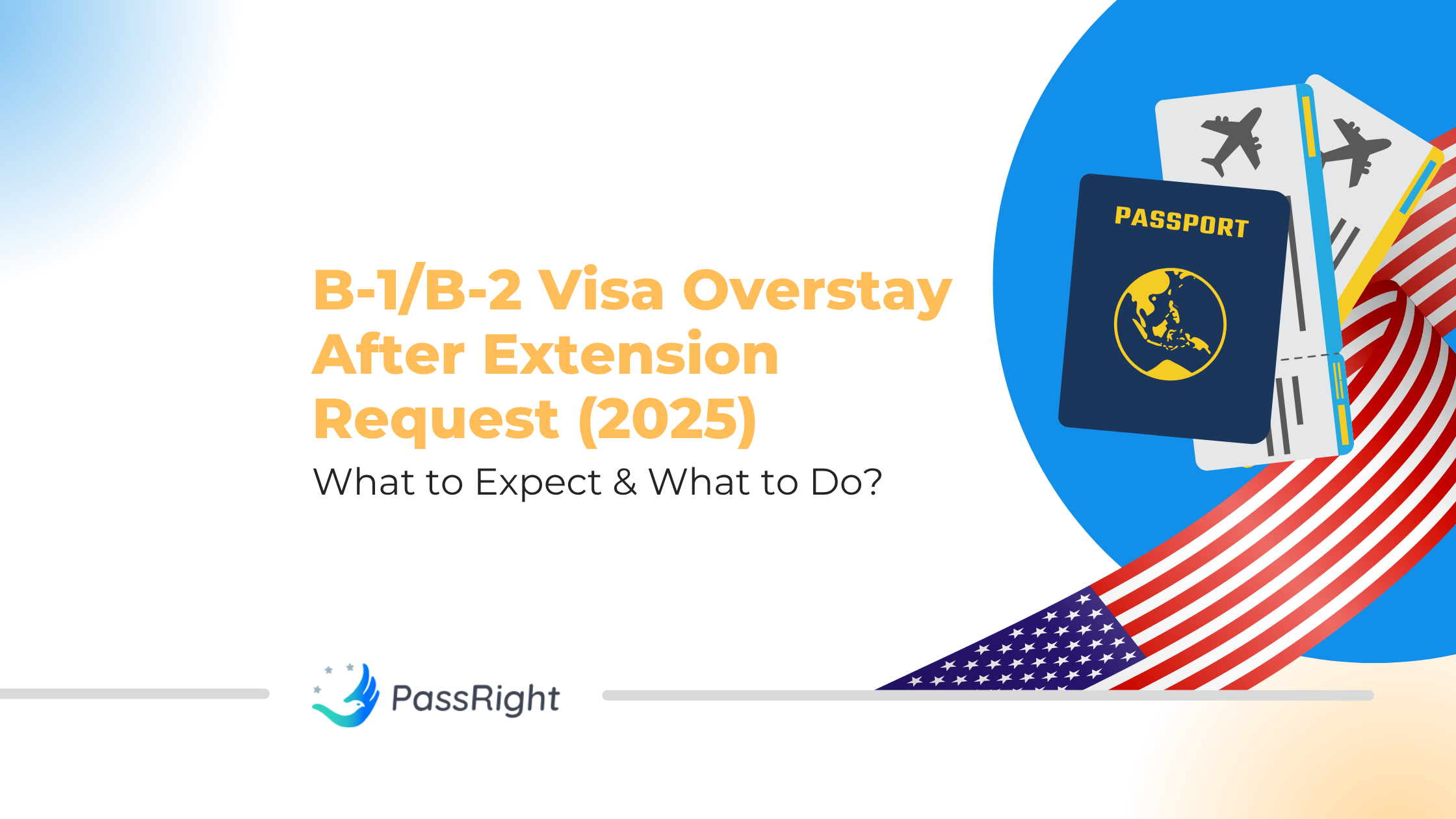A Practical Guide to U.S. Visa Overstays, Legal Risks, and Smarter Next Steps
Disclaimer: This article is for informational purposes only and does not constitute legal advice. For personalized assistance, please consult a licensed immigration attorney.
Overview: What Happens If You Overstay After Filing for a B-1/B-2 Extension?
If you’re in the U.S. on a B-1 (business) or B-2 (tourism) visa and your stay exceeds the date listed on your Form I-94 even after filing an extension request (Form I-539) — you could face serious immigration consequences. These may include visa cancellation, re-entry bars, and difficulty obtaining future visas.
Understanding the rules surrounding “unlawful presence” and the limits of filing an extension is essential. This guide explains what’s at stake, what counts as an overstay, and how to protect yourself from long-term immigration setbacks.
Key Highlights
-
- File early: Submit Form I-539 at least 45 days before your I-94 expiration.
- Timely filings matter: You may remain in the U.S. during the extension review, provided your request was filed on time.
- Overstay consequences:
- 180+ days of unlawful presence → potential 3-year re-entry bar.
- 365+ days → potential 10-year re-entry bar.
- 180+ days of unlawful presence → potential 3-year re-entry bar.
- File early: Submit Form I-539 at least 45 days before your I-94 expiration.
- Visa revocation risk: Overstays can result in automatic cancellation of your current B-1/B-2 visa.
- Future visa applications may be denied if you’ve overstayed previously.
- Professional guidance is recommended for any complex or high-risk situation.
Understanding the B-1/B-2 Visa and Stay Limits
The B-1 and B-2 visas are short-term non-immigrant categories allowing foreign nationals to visit the U.S. for business or tourism. Upon lawful entry, U.S. Customs and Border Protection (CBP) issues a Form I-94 indicating the authorized period of stay, typically up to six months.
If you wish to stay longer, you may apply for an extension using Form I-539, provided it’s submitted before your I-94 expires. USCIS may allow you to remain during the adjudication period, known as a period of authorized stay, even though your visa may have expired.
How to File for a Stay Extension
To request additional time in the U.S.:
- Submit Form I-539 with supporting documents (reason for stay, financial support, etc.).
- File before your I-94 expires — ideally 45+ days prior.
- Monitor your case: USCIS processing times vary; check the status regularly.
- Respond to RFEs (Requests for Evidence) promptly if additional documentation is requested.
A timely application typically allows you to remain until USCIS makes a decision. However, it does not guarantee approval. It is recommended to consult with the immigration attorney before you file for the extension, so that you have a proper plan in case your application to extend your stay is denied.
Best Practices to Avoid Overstaying in 2025
- Verify Your I-94 Expiration
Always check your I-94 online at i94.cbp.dhs.gov to confirm your departure deadline.
- File Form I-539 Early
Aim to submit your extension request at least 6 weeks in advance.
- Stay Informed
Regularly review USCIS processing times and watch for case updates.
- Respond Promptly to USCIS
Late or incomplete responses to RFEs can cause delays or denials.
- Get Legal Help When Needed
If you anticipate complications — or already face a delay or denial — an immigration attorney can help assess your options.
- Depart If Necessary
If it becomes clear your stay cannot be extended lawfully, departing before your I-94 expires may help avoid triggering bars.
Exploring Other Visa Options
Depending on your background, education, or personal circumstances, you might qualify for other U.S. visa categories:
-
- F-1: For full-time academic students.
- J-1: For educational/cultural exchange programs.
- H-4: For dependents of H-1B holders.
- F-1: For full-time academic students.
- O-1: For individuals with extraordinary ability (arts, science, business).
Each has unique eligibility rules and application steps. Many require consular processing abroad and cannot be pursued from within the U.S. while out of status.
FAQ – Your Top Questions Answered
Can I stay while my B-1/B-2 extension is pending?
Yes — if your Form I-539 was timely and properly filed, you may stay during USCIS review under a period of authorized stay. This is not the same as having lawful immigration status.Is an overstay the same as being undocumented?
Overstaying may lead to unlawful presence, but if you have a pending application, you may still be in a period of authorized stay. Being “undocumented” usually means having no valid immigration status or application in process.Can I leave the U.S. to stop unlawful presence?
Yes. Departing the U.S. halts the accrual of unlawful presence, but if you’ve already overstayed, it may activate a re-entry bar depending on how long you were unlawfully present. You need to consult your situation with the immigration attorney.Are waivers available for overstay penalties?
Certain waivers exist for eligible individuals facing re-entry bars, but they typically require demonstrating extreme hardship to qualifying U.S. relatives and are best pursued with professional legal support.
Conclusion: Staying Informed, Staying Legal
Overstaying a B-1/B-2 visa, even when done unintentionally after requesting an extension, can result in serious, long-lasting immigration consequences. The best protection is proactive planning: track your dates, understand USCIS timelines, and seek guidance early.









